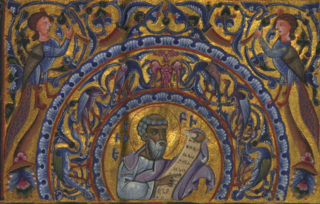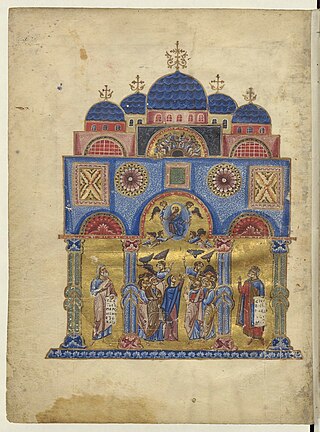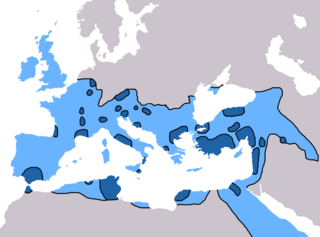Related Research Articles

Eusebius of Caesarea, also known as Eusebius Pamphilus, was a Greek Syro-Palestinian historian of Christianity, exegete, and Christian polemicist. In about AD 314 he became the bishop of Caesarea Maritima in the Roman province of Syria Palaestina. Together with Pamphilus, he was a scholar of the biblical canon and is regarded as one of the most learned Christians during late antiquity. He wrote Demonstrations of the Gospel, Preparations for the Gospel and On Discrepancies between the Gospels, studies of the biblical text. As "Father of Church History", he produced the Ecclesiastical History, On the Life of Pamphilus, the Chronicle and On the Martyrs. He also produced a biographical work on Constantine the Great, the first Christian Roman emperor, who was Augustus between AD 306 and AD 337.

The First Council of Nicaea was a council of Christian bishops convened in the Bithynian city of Nicaea by the Roman Emperor Constantine I. The Council of Nicaea met from May to the end of July 325.

Year 331 (CCCXXXI) was a common year starting on Friday of the Julian calendar. At the time, it was known as the Year of the Consulship of Bassus and Ablabius. The denomination 331 for this year has been used since the early medieval period, when the Anno Domini calendar era became the prevalent method in Europe for naming years.
The 330s decade ran from January 1, 330, to December 31, 339.
Socrates of Constantinople, also known as Socrates Scholasticus, was a 5th-century Greek Christian church historian, a contemporary of Sozomen and Theodoret.

Flavia Julia Helena, also known as Helena of Constantinople and in Christianity as Saint Helena, was an Augusta of the Roman Empire and mother of Emperor Constantine the Great. She was born in the lower classes traditionally in the Greek city of Drepanon, Bithynia, in Asia Minor, which was renamed Helenopolis in her honor, although several locations have been proposed for her birthplace and origin.

Constantine V was Byzantine emperor from 741 to 775. His reign saw a consolidation of Byzantine security from external threats. As an able military leader, Constantine took advantage of civil war in the Muslim world to make limited offensives on the Arab frontier. With this eastern frontier secure, he undertook repeated campaigns against the Bulgars in the Balkans. His military activity, and policy of settling Christian populations from the Arab frontier in Thrace, made Byzantium's hold on its Balkan territories more secure.
This is an alphabetical index of people, places, things, and concepts related to or originating from the Byzantine Empire. Feel free to add more, and create missing pages. You can track changes to the articles included in this list from here.
Quartodecimanism is the name given to the practice of celebrating the death of Christ on the day of Passover, the 14th of Nisan according to biblical dating, on whatever day of the week it occurs. The Quartodeciman controversy in the Church was the question of whether to celebrate Easter on Sunday, or on Passover.
Salamanes Hermias Sozomenos, also known as Sozomen, was a Roman lawyer and historian of the Christian Church.

The Church of the Holy Apostles, also known as the Imperial Polyandrion, was a Byzantine Eastern Orthodox church in Constantinople, capital of the Eastern Roman Empire. The first structure dated to the 4th century, though future emperors would add to and improve upon it. It was second in size and importance only to the Hagia Sophia among the great churches of the capital.

During the reign of the Roman Emperor Constantine the Great, Christianity began to transition to the dominant religion of the Roman Empire. Historians remain uncertain about Constantine's reasons for favoring Christianity, and theologians and historians have often argued about which form of early Christianity he subscribed to. There is no consensus among scholars as to whether he adopted his mother Helena's Christianity in his youth, or, as claimed by Eusebius of Caesarea, encouraged her to convert to the faith he had adopted.
The Arian controversy was a series of Christian disputes about the nature of Christ that began with a dispute between Arius and Athanasius of Alexandria, two Christian theologians from Alexandria, Egypt. The most important of these controversies concerned the relationship between the substance of God the Father and the substance of His Son.

The Church History of Eusebius, the bishop of Caesarea, was a 4th-century pioneer work giving a chronological account of the development of Early Christianity from the 1st century to the 4th century. It was written in Koine Greek, and survives also in Latin, Syriac and Armenian manuscripts.

Christianity in the 4th century was dominated in its early stage by Constantine the Great and the First Council of Nicaea of 325, which was the beginning of the period of the First seven Ecumenical Councils (325–787), and in its late stage by the Edict of Thessalonica of 380, which made Nicene Christianity the state church of the Roman Empire.

The Religious policies of Constantine the Great have been called "ambiguous and elusive." Born in 273 during the Crisis of the Third Century, Constantine the Great was thirty at the time of the Great Persecution. He saw his father become Augustus of the West and then shortly die. Constantine spent his life in the military warring with much of his extended family, and converted to Christianity sometime around 40 years of age. His religious policies, formed from these experiences, comprised increasing toleration of Christianity, limited regulations against Roman polytheism with toleration, participation in resolving religious disputes such as schism with the Donatists, and the calling of councils including the Council of Nicaea concerning Arianism. John Kaye characterizes the conversion of Constantine, and the Council of Nicea that Constantine called, as two of the most important things to ever happen to the Christian church.

The Tyche of Constantinople was the deity of fortune (Tyche) who embodied the guardianship (tutela) of the city of Constantinople in the Roman Imperial era. Malalas says that her name was Anthousa. Her attributes included the mural crown, cornucopia, a ship's prow, and a spear. She was depicted standing or seated on a throne. As the personification of the city, Tyche or Anthousa could be abstracted from her origins as a Classical goddess, and like Victory made tolerable as a symbol for Christians. Under Constantine, the Tychai of Rome and Constantinople together might be presented as personifications of the empire ruling the world.
The Diocese of Scythopolis is a titular see in Israel/Jordan and was the Metropolitan of the Roman province of Palestina II. It was centered on Modern Beth Shean (Bêsân).
Hellenization in the Byzantine Empire describes the spread and intensification of ancient Greek culture, religion and language in the Byzantine Empire. The theory of Hellenization generally applies to the influence of foreign cultures subject to Greek influence or occupation, which includes the ethnic and cultural homogenisation which took place throughout the life of the Byzantine Empire (330-1453).
The Church of St Acacius was an early Christian church in Constantinople. It may have been dedicated to a military saint and martyr of the Diocletianic Persecution, Saint Acacius, or it may have acquired its name from a comes Acacius, an official under the augustus Constantine the Great.
References
- ↑ "Имена святых, упоминаемых в месяцеслове". azbyka.ru (in Russian). Retrieved 2021-06-26.
- ↑ "St. Apphia, the Martyr of the Seventy | Antiochian Orthodox Christian Archdiocese". ww1.antiochian.org. Retrieved 2021-06-26.
- ↑ "Равноапостольный Гора́зд Охридский, епископ". azbyka.ru (in Russian). Retrieved 2021-06-26.
- ↑ Ostrogorsky, George. "The Byzantine Emperor and the Hierarchical World Order" in The Slavonic and East European Review, Vol. 35, No. 84. (Dec., 1956), 2
- ↑ Eusebius of Caesarea, Life of Constantine. Translated by Rev. Arthur Cushman McGiffert, Ph.D.,(New York: Christian Literature Publishing Co., 1890), bk. IV, 60
- ↑ Norwich, John Julius. A Short History of Byzantium (New York: Vintage Books, 1999), 18
- ↑ Rev. Francis X and Perry J. Cahall. History of the (1) Early Church in "New Catholic Encyclopedia Supplement 2010 Volume 1" Ed. Robert L. Fastiggi. (Detroit: Gale, Cengage Learning ; Washington, D.C. : In association with Catholic University of America, 2010), 268
- ↑ Nichols, Aidan O.P. Rome and the Eastern Churches, a Study in Schism (San Francisco: Ignatius Press, 2010), 182f
- ↑ Bardill, Jonathan. Constantine, Divine Emperor of the Christian Golden Age (New York: Cambridge university Press, 2012), 373, 392
- ↑ Dagron, Gilbert. Emperor and Priest: the Imperial Office in Byzantium translated by Jean Birrell, (Cambridge: University Press, 2003), 141f
- ↑ Sozomen. Ecclesiastical History II, 34
- ↑ BHG 362
- ↑ Anna Komnene. Alexiad XIV, 8
- ↑ Treitinger, Otto. Die oströmische Kaiser- und Reichsidee nach ihrer Gestaltung im höfischen Zeremoniell (Darmstadt: H. Gentner., 1956), 129f
- ↑
- Greek: ἰσαπόστολος, translit. isapóstolos
- Latin: aequalis apostolis
- Arabic: معادل الرسل, muʿādil ar-rusul
- Georgian :მოციქულთასწორი, romanized:motsikultasts'ori
- Romanian: întocmai cu Apostolii
- Russian: равноапостольный, ravnoapostol'nyj
- Bulgarian and Serbian: равноапостолни, ravnoapostolni
- Albanian: i barabartë me Apostojët
- Ukrainian: рівноапостольний